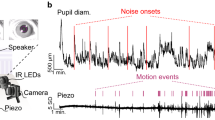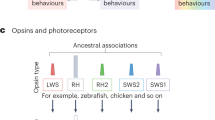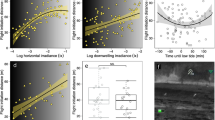Abstract
HUMANS cannot see the near ultraviolet (UV) wavelengths (320–400 nm) in sunlight. By analogy, it is often assumed that most vertebrates are also UV-blind1. This generalisation has been called into question by recent experimental evidence showing that toads, newts, lizards, and hummingbirds are behaviourally responsive to UV light2–5. We present here evidence suggesting that homing pigeons (Columba livia) are sensitive to UV wavelengths and capable of responding to the intensities of UV light that prevail in nature. Our results were obtained by a cardiac conditioning technique used previously to demonstrate homing pigeon sensitivity to barometric pressure changes, polarised light and infrasound6–10.
This is a preview of subscription content, access via your institution
Access options
Subscribe to this journal
Receive 51 print issues and online access
$199.00 per year
only $3.90 per issue
Buy this article
- Purchase on Springer Link
- Instant access to full article PDF
Prices may be subject to local taxes which are calculated during checkout
Similar content being viewed by others
References
Tansley, K. Vision in Vertebrates (Chapman and Hall. London, 1965).
Huth, H. & Burkhardt, D. Naturwissenschaften 59, 650 (1972).
Dietz, M. Naturwissenschaften 59, 316 ( 1972).
Kimeldorf, D. J. & Fontanini, D. F. Envir. Physiol. Biochem. 4, 40–44 (1974).
Moehn, L. J. Herpetol. 8, 175–183 (1974).
Kreithen, M. L. & Keeton, W. T. J. comp. Physiol. 89, 73–82 (1974).
Kreithen, M. L. & Keeton, W. T. J. comp. Physiol. 89, 83–92 (1974).
Yodlowski, M. L., Kreithen, M. L. & Keeton, W. T. Nature 265, 725–726 (1977).
Kreithen, M. L. in Neural Mechanisms of Behavior in the Pigeon (ed. Granada, A.) (Plenum, New York, in the press).
Kreithen, M. L. in Proc. 1977 Symp. Anim. Migration Homing (eds Schmidt-Koenig, K. G. & Keeton, W. T.) (Springer, Berlin, in the press)
Blough, P. M. J. exp. Analysis Behav. 15, 57–67 (1971).
Wright, A. J. exp. Analysis Behav. 17, 325–337 (1972).
LeGrand, Y. Light, Color and Vision, 2nd edn (Chapman and Hall, London, 1968).
Kennedy, D. & Milkman, R. D. Biol. Bull. 111, 375–386 (1956).
Muntz, W. R. A. in Handbook of Sensory Physiology 7 (ed. Dartnall, H.) 529–565 (Springer, Berlin, 1972).
Govardovski, V. I. & Zueva, L. V. Vis. Res. 17, 537–543 (1977).
Frisch, K. von. The Dance Language and Orientation of Bees. (Harvard University Press, Cambridge, Massachusetts, 1967).
Author information
Authors and Affiliations
Rights and permissions
About this article
Cite this article
KREITHEN, M., EISNER, T. Ultraviolet light detection by the homing pigeon. Nature 272, 347–348 (1978). https://doi.org/10.1038/272347a0
Received:
Accepted:
Published:
Issue Date:
DOI: https://doi.org/10.1038/272347a0
This article is cited by
-
Cues indicating location in pigeon navigation
Journal of Comparative Physiology A (2015)
-
UV reflectance of eggs of brown-headed cowbirds (Molothrus ater) and accepter and rejecter hosts
Journal of Ornithology (2008)
-
Color vision of the budgerigar (Melopsittacus undulatus): hue matches, tetrachromacy, and intensity discrimination
Journal of Comparative Physiology A (2005)
-
The roles of receptor noise and cone oil droplets in the photopic spectral sensitivity of the budgerigar, Melopsittacus undulatus
Journal of Comparative Physiology A (2003)
-
Attraction of kestrels to vole scent marks visible in ultraviolet light
Nature (1995)
Comments
By submitting a comment you agree to abide by our Terms and Community Guidelines. If you find something abusive or that does not comply with our terms or guidelines please flag it as inappropriate.



